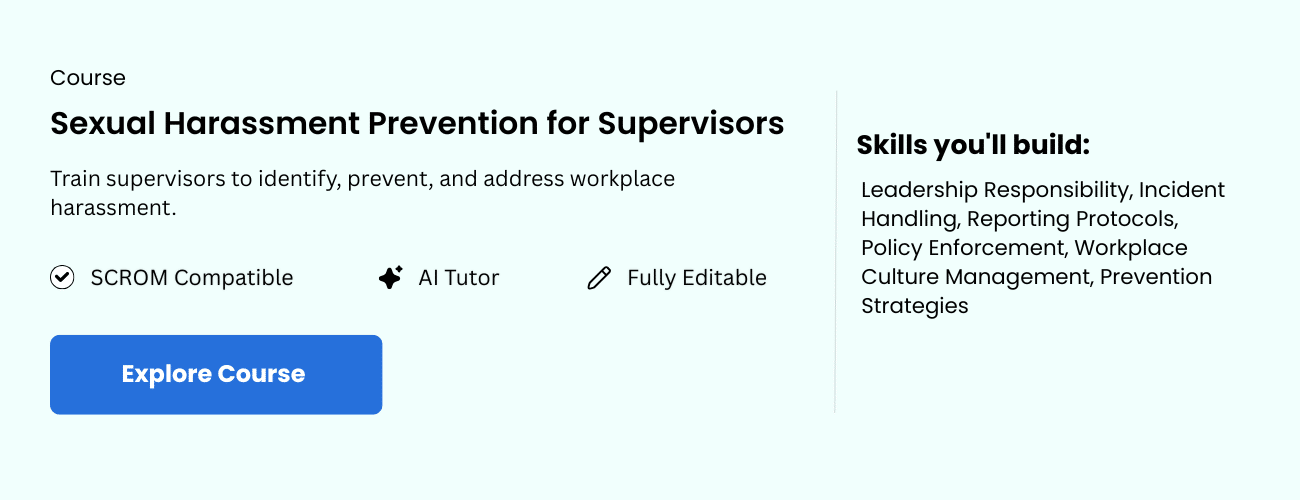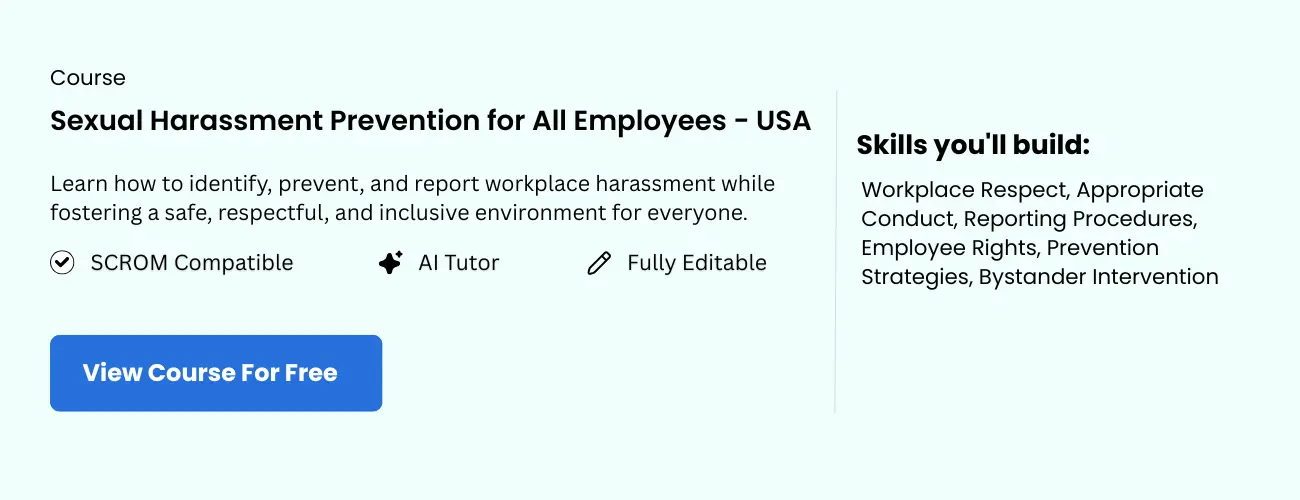Understanding Washington State Sexual Harassment Training Requirements
Sexual harassment in the workplace remains a significant concern that organizations must proactively address to maintain a safe and respectful environment. In Washington State, legal mandates require employers to provide comprehensive sexual harassment prevention training to all employees, ensuring they are equipped with the knowledge to recognize, report, and prevent inappropriate behavior.
These regulations emphasize Sexual Harassment Prevention for All Employees, reinforcing the importance of universal awareness regardless of job role, department, or seniority. By ensuring everyone understands their rights, responsibilities, and reporting procedures, organizations can create a stronger, more unified response against harassment.
Complying with Washington’s laws not only helps prevent legal and reputational risks but also promotes a positive organizational culture built on respect, accountability, diversity, and inclusion. Effective training empowers employees to speak up, supports safer workplaces, and helps organizations uphold the highest compliance standards.
Legal Foundations for Sexual Harassment Training
Washington’s training regulations are grounded in key statutes such as the Washington Law Against Discrimination (WLAD) and federal laws like Title VII of the Civil Rights Act. WLAD prohibits employment discrimination based on sex, gender identity, and other protected characteristics, explicitly including harassment. Enforcement agencies like the Washington State Human Rights Commission (WSHRC) oversee compliance efforts, emphasizing the importance of ongoing education to prevent workplace misconduct.
Mandatory Training Requirements in Washington State
- Employers with four or more employees must provide sexual harassment training.
- Training must be conducted for all new hires within 90 days of their start date.
- Annual refresher courses are required to maintain awareness and understanding.
Who Must Complete the Training
- Employees: All new employees must complete initial training within 90 days of hire.
- Supervisors and Managers: Are required to undergo specialized training to effectively address and prevent harassment.
- Independent Contractors & Temporary Staff: May also need training depending on their work arrangements.
Timing and Frequency of Training
New employees should complete their initial training within 90 days. Refresher courses are to be delivered at least every two years, ensuring ongoing awareness of legal rights and safe workplace practices. When staff changes occur, new hires must be trained promptly to maintain compliance and safety standards.
Duration and Content of Training
Sessions should last at least one hour for general employees and two hours for supervisors. Content must address:
- Definitions and examples of sexual harassment
- Legal rights and employer responsibilities under Washington law
- Reporting procedures and complaint mechanisms
- Resources and support for victims
- The importance of a harassment-free workplace
Providing comprehensive and engaging training ensures employees are well-informed and prepared to foster a respectful work environment.

Legal Foundations and Regulatory Framework
Washington’s approach to sexual harassment prevention is rooted in a mix of federal and state laws designed to promote safe workplaces. Federal laws like the Civil Rights Act, reinforced by the EEOC, mandate anti-harassment policies in workplaces with 15 or more employees. State laws, including WLAD and specific mandates from the Washington State Human Rights Commission, strengthen these protections by requiring regular, interactive training for all employees, supervisors, and contractors.
Federal Laws Governing Sexual Harassment
The Civil Rights Act’s Title VII prohibits harassment based on sex, and the EEOC enforces these provisions by requiring organizations to implement effective policies and conduct regular training to identify and prevent harassment.
State Regulations in Washington
Washington’s WLAD explicitly forbids workplace discrimination and harassment related to sex, gender identity, and expression. The law mandates annual training for all employees, reinforcing the state’s commitment to eradicating workplace misconduct and promoting respect and equality.
Employer Responsibilities
Employers must establish clear anti-harassment policies, provide training at least annually, investigate complaints promptly, and communicate expectations effectively. Failure to comply can result in legal penalties, damage to reputation, and increased liability.
Employee and Contractor Responsibilities
All workers should actively participate in training sessions, understand reporting channels, and uphold a respectful workplace culture. Timely training and adherence to policies are essential for maintaining compliance and safety.
Specifics of the Training Mandate
To stay compliant, organizations must understand the specifics of the training requirements—timing, content, and delivery. The initial training should take place within the first 30 days of employment, with refresher courses every 12 to 24 months to ensure continuous awareness of legal standards and best practices.
Training Frequency Requirements
Mandatory training must be completed upon hiring, with regular updates to reinforce legal obligations. Refreshers help address evolving workplace issues, legal updates, and societal expectations.
Initial vs. Refresher Courses
Initial training provides the foundation for understanding safe practices. Refresher courses renew knowledge, address new regulations, and reinforce respectful behavior, fostering an ongoing culture of compliance.
Content Coverage
Training should include:
- Definitions of harassment and examples
- Legal rights and employer responsibilities
- Reporting procedures and confidentiality
- Prevention strategies, including bystander intervention
- Workplace safety procedures and resources
Regularly updating content ensures alignment with current laws and societal standards, fostering a proactive approach to prevention.
Components and Best Practices for Effective Sexual Harassment Training
Effective sexual harassment training combines legal requirements with engaging delivery methods to promote a respectful and inclusive workplace. Beyond legal compliance, these programs aim to change workplace culture, reduce incidents, and empower employees to act appropriately. Here, we discuss core topics, innovative training methods, and the latest trends shaping successful programs.
Core Topics for Comprehensive Sexual Harassment Training
Training must cover essential areas, including:
- Understanding Sexual Harassment: Clear definitions and examples of unwelcome conduct, covering verbal, physical, or visual behaviors.
- Legal Framework and Responsibilities: An overview of federal and state laws, emphasizing organizational and individual duties.
- Recognizing and Preventing Harassment: How to identify potential issues early and promote proactive behaviors.
- Reporting Procedures and Support Systems: Clear channels for confidential reporting and support resources.
- Bystander Intervention Strategies: Training employees to safely intervene in inappropriate situations, promoting collective responsibility.
Innovative Engagement Methods
Traditional training methods often lack engagement; modern approaches improve participation and retention:
- Multimedia Content: Videos, animations, and real-world scenarios enhance understanding and appeal to diverse learning styles.
- Interactive Assessments: Quizzes, role-plays, and simulations reinforce learning and provide immediate feedback.
- Accessible Design: Incorporating closed captions, audio descriptions, and multilingual content increases inclusivity.
- Technology Leveraging: Virtual reality, mobile apps, and online platforms enable remote, flexible, and immersive training experiences.
Recent Trends and Compliance Updates
Keeping training current involves integrating new legal requirements and technological advances:
- Using AI and data analytics to personalize learning and monitor engagement.
- Including broader topics like implicit bias and diversity to foster a comprehensive understanding of respectful workplace behavior.
- Implementing regular refresher courses—at least annually—to stay aligned with evolving standards.
- Incorporating virtual reality to simulate scenarios for enhanced empathy and response skills.
Compliance Penalties and How to Stay Ahead
Failing to meet training and compliance standards can result in severe penalties, legal issues, and reputational harm. Understanding these consequences helps organizations prioritize continuous compliance efforts.
The Consequences of Non-Compliance
The impact of non-compliance includes:
- Financial Penalties: Fines imposed by agencies like OSHA or GDPR can reach hundreds of thousands to millions of dollars, depending on violations.
- Legal Liabilities: Increased risk of lawsuits, damages, and legal costs stemming from unaddressed misconduct or negligence.
- Reputational Damage: Publicized violations diminish stakeholder trust and consumer confidence, which can have long-term business impacts.
- Operational Disruptions: Regulatory actions may cause shutdowns, investigations, or mandated corrective measures, hindering business continuity.
Resources for Maintaining Proper Training Documentation
Effective record-keeping includes:
- Utilizing digital compliance management systems (e.g., SAP SuccessFactors, Workday)
- Keeping certificates and logs from training providers
- Maintaining detailed records of employee participation and certifications
- Regular audits and updates of records for accuracy and completeness
Proactive documentation supports audits, legal defenses, and demonstrates organizational diligence.
Consequences of Non-Compliance
Ignoring mandatory training can lead to penalties such as hefty fines, legal claims, and reputation loss. OSHA fines, for example, can reach over $13,000 per violation, while GDPR violations can impose substantial fines up to 4% of global annual revenue. Companies also face increased litigation risks and damage to brand trust, which can be challenging and costly to repair. These consequences underscore the importance of maintaining rigorous training standards and documentation.
Actionable Steps for Employers and HR Professionals
Employers and HR teams are responsible for fostering a respectful workplace through strategic planning and continuous improvement. Here are practical steps to develop, implement, and sustain effective training programs:
Develop Compliance-Driven Training Programs
Design engaging modules that meet legal standards, incorporating real-world scenarios and interactive elements to enhance learning. Collaborate with legal and safety experts to ensure content accuracy and relevance.
Schedule Regular Policy Reviews and Updates
Review and update training materials at least annually, integrating recent legal developments and organizational feedback. Use surveys and focus groups to gauge training effectiveness and identify gaps.
Foster a Respectful and Inclusive Culture
Leadership should demonstrate commitment by modeling respectful behavior, establishing clear policies, and encouraging open dialogue. Recognize positive behaviors and provide resources like Employee Assistance Programs (EAPs).
Practical Tips for Success
- Implement Learning Management Systems (LMS) to track participation and compliance.
- Make training mandatory for onboarding and annual refreshers.
- Use data to monitor progress, incident reports, and feedback for continuous improvement.
Conclusion
Fostering a safe, respectful, and inclusive workplace is crucial for organizational success. Compliance with Washington State’s sexual harassment training laws not only fulfills legal requirements but also demonstrates a commitment to employee well-being and organizational integrity.
Regular, engaging training, transparent policies, and proactive leadership cultivate a culture where everyone feels valued and protected. By integrating ongoing education and respectful practices, organizations can prevent misconduct, reduce risks, and promote a thriving, productive environment for all.













